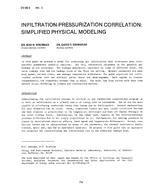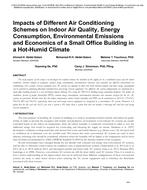Click here to purchase
Diffused Ceiling Ventilation (DCV) has been widely used in ordinary offices, schools and residential premises and it quickly becoming an alternative to Mixing Ventilation (MV) which has been traditionally used. This paper presents a comprehensive comparative assessment between MV and DCV in an ordinary office in Beirut, Lebanon, using computational fluid dynamics (CFD) simulations. In this study, a similar cooling load was assumed in both ventilation strategies and two main parameters affecting the ventilation performance in DCV systems, specifically plenum height and false ceiling slab thickness, were varied to check their impact. The findings from the assessment revealed that the increase in the false ceiling slab thickness caused a notable reduction in the average volume temperature in the office by 4.9% while the impact of modifying the plenum height was less pronounced. The observed reduction in temperatures was further substantiated by the achieved thermal comfort indices (PMV and PPD) which comply with the comfort ranges defined in ASHRAE 55.
Citation: 4th Intl Conf: Efficient Bldg Design
Product Details
- Published:
- 2020
- Number of Pages:
- 9
- Units of Measure:
- Dual
- File Size:
- 1 file , 2.3 MB
- Product Code(s):
- D-ICEB20-21


